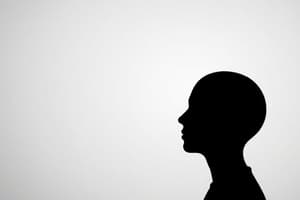Podcast
Questions and Answers
What type of representation focuses on storing an object's structure independently of its appearance to the viewer?
What type of representation focuses on storing an object's structure independently of its appearance to the viewer?
- Figure-Ground
- Feature-Analysis System
- Landmark-centered representation
- Object-centered representation (correct)
Which perceptual phenomenon occurs when an object appears to maintain the same size despite changes in the proximal stimulus?
Which perceptual phenomenon occurs when an object appears to maintain the same size despite changes in the proximal stimulus?
- Color constancy
- Size constancy (correct)
- Figure-Ground effect
- Depth perception
When referring to depth perception, what is usually used as a reference surface for understanding distance from a surface?
When referring to depth perception, what is usually used as a reference surface for understanding distance from a surface?
- Context effect
- Viewer-centered representation (correct)
- Feature-Analysis System
- Landmark-centered representation
Which law states that we tend to perceive visual arrays in a way that most simply organizes elements into a stable form?
Which law states that we tend to perceive visual arrays in a way that most simply organizes elements into a stable form?
Which system is specialized in recognizing larger configurations of objects rather than analyzing their parts?
Which system is specialized in recognizing larger configurations of objects rather than analyzing their parts?
What does the term 'figure' refer to in the context of figure-ground perception?
What does the term 'figure' refer to in the context of figure-ground perception?
What is a Monocular Depth Cue?
What is a Monocular Depth Cue?
Which condition results in a severely impaired ability to recognize human faces?
Which condition results in a severely impaired ability to recognize human faces?
What does the condition of Ataxia result from?
What does the condition of Ataxia result from?
What is Simultanagnosia characterized by?
What is Simultanagnosia characterized by?
How is Optic Ataxia defined?
How is Optic Ataxia defined?
What is a Binocular Depth Cue based on?
What is a Binocular Depth Cue based on?
Which theory suggests that our minds store myriad sets of templates to help in perception?
Which theory suggests that our minds store myriad sets of templates to help in perception?
According to Recognition-by-Components (RBC) Theory, how do we quickly recognize objects?
According to Recognition-by-Components (RBC) Theory, how do we quickly recognize objects?
What is the main concept behind Color Constancy?
What is the main concept behind Color Constancy?
How do Context Effects influence perception?
How do Context Effects influence perception?
What does Viewer-Centered Representation refer to?
What does Viewer-Centered Representation refer to?
Which theory suggests that perception is influenced not just by the external world but also by our experiences?
Which theory suggests that perception is influenced not just by the external world but also by our experiences?
Study Notes
Basic Concepts of Perception
- Perception involves identity and form, pattern and movement, and is used to determine further goals through cognition.
Approaches to Perception
- Bottom-Up Theories: Perception starts with sensory stimuli, and information is processed from the eye to the brain.
- Direct Perception: Information in sensory receptors, including sensory context, is sufficient to perceive anything.
- Template Theories: The mind stores templates, and perception involves matching features to these templates.
- Feature-Matching Theories: Perception involves matching features of a pattern to stored memories.
- Recognition-by-Components (RBC) Theory: Objects are recognized by observing their edges and decomposing them into geons.
Top-Down Theories
- Data-Driven Perception: Perception is driven by high-level cognitive processes, existing knowledge, and prior expectations.
- Constructive Perception: Perception is influenced by both the world and our experiences.
- Color Constancy: The color of an object appears constant despite changes in lighting.
- Context Effects: The surrounding environment influences perception.
- Viewer-Centered Representation: Perception is based on the object's appearance to the viewer.
- Object-Centered Representation: Perception is based on the object's shape, independent of its appearance.
- Landmark-Centered Representation: Perception is based on the relationship to a well-known item.
Laws of Perception
- Law of Pragnanz: Visual arrays are perceived in a way that most simply organizes elements into a stable and coherent form.
- Figure-Ground: A figure is perceived as highlighted against a background.
- Feature-Analysis System: Specializes in recognizing parts of objects and assembling them into wholes.
- Configurational System: Recognizes larger configurations, not analyzing parts of objects.
Perceptual Constancy
- Perceptual Constancy: Perception of an object remains the same despite changes in proximal sensation.
- Size Constancy: Perception of an object's size remains constant despite changes in the size of the proximal stimulus.
Depth Perception
- Depth: Distance from a surface, using the body as a reference.
- Depth Cues: Depth perception may depend on more than just distance or depth at which an object is located.
- Monocular Depth Cue: Can be represented in two dimensions and observed with one eye.
- Binocular Depth Cue: Based on sensory information in three dimensions from both eyes.
Deficits in Perception
- Agnosia: Trouble perceiving sensory information, often caused by damage to the temporal and occipital lobes or restricted oxygen flow.
- Simultagnosia: Inability to pay attention to more than one object at a time.
- Prosopagnosia: Severely impaired ability to recognize human faces.
- Optic Ataxia: Impaired ability to use the visual system to guide movement.
- Ataxia: Results from a processing failure in the posterior parietal cortex, where sensorimotor information is processed.
Studying That Suits You
Use AI to generate personalized quizzes and flashcards to suit your learning preferences.
Description
Test your knowledge on object-centered and landmark-centered representations in psychology. Explore concepts like shape stability across orientations and the law of Pragnanz.



